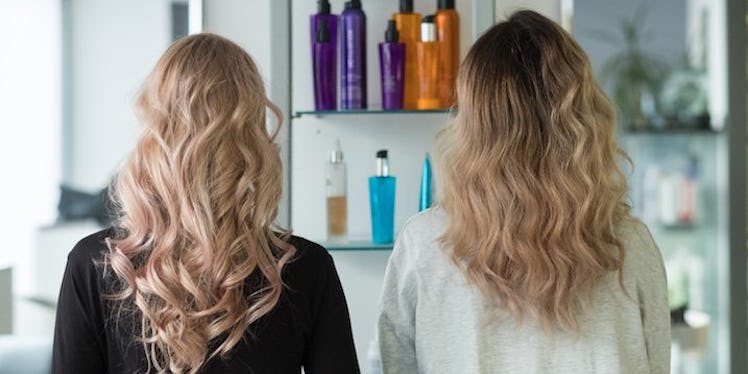
How To Get The Bounce Back In Your Faded Curls, As Told By An Expert
When I was in college, in sub-zero temperatures, I had the best hair of my life.
I went to Syracuse University, where snow days weren't a thing because it snowed every day, and we still went out to the bars in dresses and tights when it was -5 outside.
But despite the insane weather, something about it worked wonders for my hair.
After freshman year, I realized if I scrunched a bit of drugstore hairspray into my damp strands, I could wake up the next day with flawless waves (dare I say, curls).
I spent years doing this (Why fix something that isn't broken?), and I was constantly amazed at how effortless it was to have bouncy waves full of body.
But then, of course, everything changed.
I don't even remember it happening, but one day I realized my perfect curls were gone.
Sure, this was after a brief bout with going blonde, but even when I returned back to my natural roots, I couldn't get the curls I once had. I was left with more of a piecey wave.
Despite my history of using drugstore hairspray and $1 twist up lipsticks, I've been in the magazine and beauty world long enough to realize there are experts who can solve ANY beauty blunder.
So, after a bit of research, I found DevaCurl. The brand specializes in getting the most out of your curls, and even though I only had waves, I figured they could help me figure out what my issue was.
I spoke with DevaCurl stylists to see if there was any hope in salvaging my curly hair.
Here are a few things I learned:
Your hair changes with your hormones.
According to Devachan NYC senior stylist, Susan Ekrom, the shift in hair texture can naturally come around with age.
After the initial stage of puberty in our teen years, in our early to mid-20s, we move into our adult menstrual years.
During this time, many different factors affect your hormones, including alcohol and caffeine intake. This could be one of the reasons I noticed the shift in my hair shortly after graduating college.
I also moved from extremely cold Syracuse to New York City, one of the most humid locations in all of New York State.
A new location, climate and lifestyle could all be factors of changing hair texture.
Use products that don't weigh down your hair.
So, what can be done about my hair if I can't move locations?
As you can see below my hair was truly looking flat AF. It didn't look pin straight, but definitely looked awkward, like some body and life was trying to squeak out of it.
According to Susan, you should check the ingredients list on your products.
Susan and her assistants schooled me in the hairspray I was still using on my damp hair. They mentioned how silicone in a product is the first thing to weigh down your hair and does little to lock in moisture.
WTF does "damp" hair really mean?
If you look at the back bottle of any hair product, it usually says "apply to damp hair."
I long figured damp hair meant something along the lines of the amount of wetness still left on your hair after squeezing it out with a towel and waiting around for about 15 minutes.
Turns out, I was very wrong.
Devachan assistant, Jemeliah Ayyad, showed me applying product to damp hair means the hair that's literally still dripping wet from the wash.
She had me flip my wet hair over, and generously applied two large handfuls of volumizing foam to soaking wet strands. Using a constant squeezing motion with your hands, you absorb the product into the hair.
According to Jemeliah, soaking wet hair is best so the product can go into the cuticle of your hair, and really lock in moisture.
After the first two handfuls were in, Jemeliah applied another handful of product into a paper towel, and worked it into the hair that way.
If there's too much water dripping out of your hair, you should always squeeze it with a paper towel or microfiber towel. Terry cloth towels only strip your hair of moisture.
Is there hope?
Even after I explained my situation to the Devachan stylists, they seemed confident they could get at least a "good wave" out of my hair.
After letting my hair naturally air dry, there was definitely a noticeable difference.
Using more product than I usually would didn't leave my hair crunchy or dry. The wave was flawless, and looked as though there was no product in it at all.
All in all, I found a new product to replace my hairspray, and learned how to apply it -- at the right time -- for maximum wave.
I may not be able to call my hair curly anymore, but it's definitely not flat.
And coming from someone who's former hair routine consisted only of shampoo, conditioner and hairspray, a single product replacement is a truly a life saver.